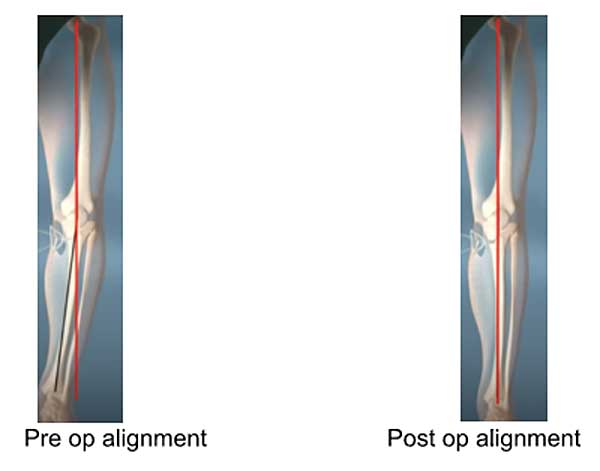Corrective High Tibial Osteotomy (HTO)
A Corrective High Tibial Osteotomy (HTO)
Patients who have knee pain most commonly on the inside of the knee joint due to arthritis affecting just one part of the knee joint. This treatment option will be discussed and explained in detail if you are a suitable candidate especially if you are young and active in whom a knee replacement would fail early due to accelerated wear of the polyethylene. You have to be able to adhere to the postoperative management instructions and recovery and there are no contraindications for you to have the surgery.
Your natural alignment of the leg may be a contributing factor in development and progression of arthritis in your knee, especially if there is an angular deformity. This causes abnormally high loads and stresses on one part of the joint (most commonly the inside of the knee joint). The leg becomes bowed further increasing the load and this can accelerate the wear and damage of the joint surface. If you are having ongoing pain and disability interfering with activities of daily living and when all non-operative all treatments have failed. A trail of off loading the worn side using a special brace will under taken to confirm that the surgery will be of benefit.
What is a HTO?
The tibia (shin bone) is carefully broken and reset and stabilised with plates and screws to allow the bone to heal in this new position. In some cases bone graft may be used to help the bone to heal.
This realignment allows the worn side of the joint to be off loaded and transfer load onto the normal side. This procedure does not return the knee to normal, it does prolong the life of the damaged knee and helps relieve pain and can delay the need for a total knee replacement.
How is it done?
You will be asleep for the operation. The site of the cut in the bone and the amount of correction needed are planned in detail prior to the operation.
Through a small incision the top of the tibia is exposed at site of the planned break and is checked on image intensifier (X-ray).
The bone is then cut, creating a break in the bone and this then allows the bones to be put into a new corrected position so realigning the leg. This position stabilised and fixed using a special plate and screws.
What are the risks?
• Wound healing problems
• Infection – wound and deep joint
• Thrombosis – legs (DVT), Pulmonary embolism (PE)
• Nerve and vessel damage, Complex Regional Pain Syndrome (CRPS)
• Sensitive wounds, Residual pain and symptoms, pain from the plate and screws, Failure of the bone to heal
• Need for further surgery and knee replacement
• Over all dissatisfaction and no improvement with the surgery
What happens after the surgery?
You will return to the ward and will monitored, your pain will be controlled and leg elevated with application of ice to reduce swelling. You will be seen by the physiotherapist and encouraged to move your leg and knee and help you get up and mobilise using crutches. If you feel well enough and have good home support then you will be allowed home the same day if not you will be kept in over night.
You will be given instruction on exercise, pain control and mobilising. You will be reviewed in clinic at two weeks for a wound check and to monitor your progress. The physiotherapists keep you under review. It takes approximately 3 months for the bone heal for you to recover from the operation. After this you will notice improvement in pain relief, movement and function for up to one year. The final result is variable and individual to each patient.
What is the outcome likely to be?
You may feel that your knee feels and looks knock kneed after the surgery, if your knee was bowed to start with. A valgus osteotomy will be performed.
With a valgus-producing HTO success rate is 50-85% at 10 years.
When you have reoccurrence of disabling arthritic symptoms a knee replacement may be required.


HTO - opening wedge on the medial side to shift load to the outside of the knee joint fixed with a special plate and locking screws.
How can you prepare for the surgery?
Keep healthy, good diet, stop smoking at least 12 weeks before your admission date as smoking can adversely affect the outcome and bone healing. Minimise your alcohol intake, avoid getting any infections and maintain good strength in your leg muscles.

- Arthritis
- Knee Arthritis
- Knee Replacement
- Corrective High Ttibial Osteotomy (HTO)
- Knee Sports Injury
- Knee Arthroscopy
- Knee Meniscus Tears
- Anterior Cruciate Ligament
- Chondral Injury / Cartilage Injury
North West Hip & Knee Clinics
Services provided:
• Keyhole (minimally invasive)
• Hip and Knee Surgery
• Hip and Knee Joint Replacement
• Hip and Knee Sports Injury
• Hip Arthroscopy, FAI and Labral Surgery<
• Knee Arthroscopy - Meniscus surgery
• Knee Arthroscopy and ACL / PCL
• Ligament Reconstruction
• Biologics – PRP, Stem Cell
• Cartilage Regeneration
Mr Aslam Mohammed Consultant Hip and Knee Surgeon